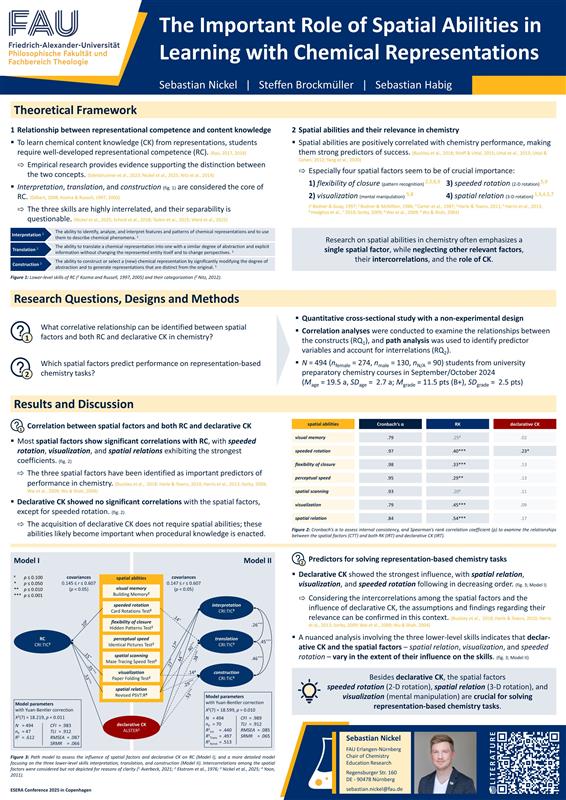The Important Role of Spatial Abilities in Learning with Chemical Representations

Download: The Important Role of Spatial Abilities in Learning with Chemical Representations
References
Averbeck, D. (2021). Zum Studienerfolg in der Studieneingangsphase des Chemiestudiums: Der Einfluss kognitiver und affektiv-motivationaler Variablen [Academic Success in the Initial Phase of Chemistry Studies: The Influence of Cognitive and Affective-Motivational Variables]. Logos Verlag.
Bodner, G. M., & Guay, R. B. (1997). The Purdue Visualization of Rotations Test. The Chemical Educator, 2(4), 1–17. https://doi.org/10.1007/s00897970138a
Bodner, G. M., & McMillen, T. L. B. (1986). Cognitive restructuring as an early stage in problem solving. Journal of Research in Science Teaching, 23(8), 727–737. https://doi.org/10.1002/tea.3660230807
Buckley, J., Seery, N., & Canty, D. (2018). A Heuristic Framework of Spatial Ability: A Review and Synthesis of Spatial Factor Literature to Support its Translation into STEM Education. Educational Psychology Review, 30(3), 947–972. https://doi.org/10.1007/s10648-018-9432-z
Carter, C. S., Larussa, M. A., & Bodner, G. M. (1987). A study of two measures of spatial ability as predictors of success in different levels of general chemistry. Journal of Research in Science Teaching, 24(7), 645–657. https://doi.org/10.1002/tea.3660240705
Edelsbrunner, P. A., Malone, S., Hofer, S. I., Küchemann, S., Kuhn, J., Schmid, R., Altmeyer, K., Brünken, R., & Lichtenberger, A. (2023). The relation of representational competence and conceptual knowledge in female and male undergraduates. International Journal of STEM Education, 10(1), 44. https://doi.org/10.1186/s40594-023-00435-6
Ekstrom, R. B., French, J. W., Harman, H. H., & Dermen, D. (1976). Kit of Factor-Referenced Cognitive Tests. Educational Testing Service.
Gilbert, J. K. (2008). Visualization: An Emergent Field of Practice and Enquiry in Science Education. In J. K. Gilbert, M. Reiner, & M. Nakhleh (Hrsg.), Visualization: Theory and Practice in Science Education (S. 3–24). Springer Netherlands. https://doi.org/10.1007/978-1-4020-5267-5_1
Harle, M., & Towns, M. (2011). A Review of Spatial Ability Literature, Its Connection to Chemistry, and Implications for Instruction. Journal of Chemical Education, 88(3), 351–360. https://doi.org/10.1021/ed900003n
Harris, J., Hirsh-Pasek, K., & Newcombe, N. S. (2013). Understanding spatial transformations: Similarities and differences between mental rotation and mental folding. Cognitive Processing, 14(2), 105–115. https://doi.org/10.1007/s10339-013-0544-6
Hodgkiss, A., Gilligan, K. A., Tolmie, A. K., Thomas, M. S. C., & Farran, E. K. (2018). Spatial cognition and science achievement: The contribution of intrinsic and extrinsic spatial skills from 7 to 11 years. British Journal of Educational Psychology, 88(4), 675–697. https://doi.org/10.1111/bjep.12211
Kozma, R., & Russell, J. (1997). Multimedia and understanding: Expert and novice responses to different representations of chemical phenomena. Journal of Research in Science Teaching, 34(9), 949–968. https://doi.org/10.1002/(SICI)1098-2736(199711)34:93.0.CO;2-U
Kozma, R., & Russell, J. (2005). Students Becoming Chemists: Developing Representationl Competence. In J. K. Gilbert (Hrsg.), Visualization in Science Education (S. 121–145). Springer Netherlands. https://doi.org/10.1007/1-4020-3613-2_8
Nickel, S., Brockmüller, S., Boone, W. J., & Habig, S. (2025). Measuring representational competence – analyses of dimensionality and the relationship to general content knowledge. International Journal of Science Education, 1–25. https://doi.org/10.1080/09500693.2025.2515621
Nitz, S. (2012). Fachsprache im Biologieunterricht: Eine Untersuchung zu Bedingungsfaktoren und Auswirkungen [Scientific Language in Biology Education: An Investigation of Influencing Factors and Effects]. Christian-Albrechts-Universität zu Kiel.
Nitz, S., Ainsworth, S. E., Nerdel, C., & Prechtl, H. (2014). Do student perceptions of teaching predict the development of representational competence and biological knowledge? Learning and Instruction, 31, 13–22. https://doi.org/10.1016/j.learninstruc.2013.12.003
Rau, M. A. (2017). Do Knowledge-Component Models Need to Incorporate Representational Competencies? International Journal of Artificial Intelligence in Education, 27(2), 298–319. https://doi.org/10.1007/s40593-016-0134-8
Rau, M. A. (2018). Making connections among multiple visual representations: How do sense-making skills and perceptual fluency relate to learning of chemistry knowledge? Instructional Science, 46(2), 209–243. https://doi.org/10.1007/s11251-017-9431-3
Scheid, J., Müller, A., Hettmannsperger, R., & Schnotz, W. (2018). Representational Competence in Science Education: From Theory to Assessment. In K. L. Daniel (Hrsg.), Towards a Framework for Representational Competence in Science Education (Bd. 11, S. 263–277). Springer International Publishing. https://doi.org/10.1007/978-3-319-89945-9_13
Sorby, S. (2009). Educational Research in Developing 3‐D Spatial Skills for Engineering Students. International Journal of Science Education, 31(3), 459–480. https://doi.org/10.1080/09500690802595839
Stieff, M., & Uttal, D. (2015). How Much Can Spatial Training Improve STEM Achievement? Educational Psychology Review, 27(4), 607–615. https://doi.org/10.1007/s10648-015-9304-8
Taskin, V., Bernholt, S., & Parchmann, I. (2015). An inventory for measuring student teachers’ knowledge of chemical representations: Design, validation, and psychometric analysis. Chemistry Education Research and Practice, 16(3), 460–477. https://doi.org/10.1039/C4RP00214H
Uttal, D. H., & Cohen, C. A. (2012). Spatial Thinking and STEM Education. In B. H. Ross (Hrsg.), Psychology of Learning and Motivation (Bd. 57, S. 147–181). Elsevier. https://doi.org/10.1016/B978-0-12-394293-7.00004-2
Uttal, D. H., Meadow, N. G., Tipton, E., Hand, L. L., Alden, A. R., Warren, C., & Newcombe, N. S. (2013). The malleability of spatial skills: A meta-analysis of training studies. Psychological Bulletin, 139(2), 352–402. https://doi.org/10.1037/a0028446
Wai, J., Lubinski, D., & Benbow, C. P. (2009). Spatial ability for STEM domains: Aligning over 50 years of cumulative psychological knowledge solidifies its importance. Journal of Educational Psychology, 101(4), 817–835. https://doi.org/10.1037/a0016127
Ward, L., Rotich, F., Raker, J. R., Komperda, R., Nedungadi, S., & Popova, M. (2025). Design, development, and evaluation of the organic chemistry representational competence assessment (ORCA). Chemistry Education Research and Practice, 26(1), 244–258. https://doi.org/10.1039/D3RP00188A
Wu, H., & Shah, P. (2004). Exploring visuospatial thinking in chemistry learning. Science Education, 88(3), 465–492. https://doi.org/10.1002/sce.10126
Yang, W., Liu, H., Chen, N., Xu, P., & Lin, X. (2020). Is Early Spatial Skills Training Effective? A Meta-Analysis. Frontiers in Psychology, 11, 1938. https://doi.org/10.3389/fpsyg.2020.01938
Yoon, S. Y. (2011). Revised Purdue Spatial Visualization Test: Visualization of Rotations (Revised PSVT:R) [Psychometric Instrument].
